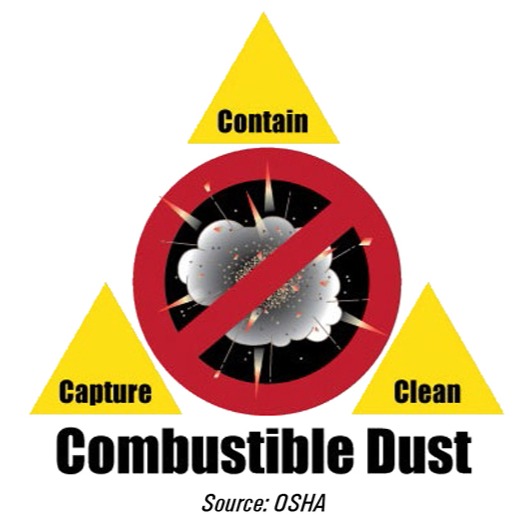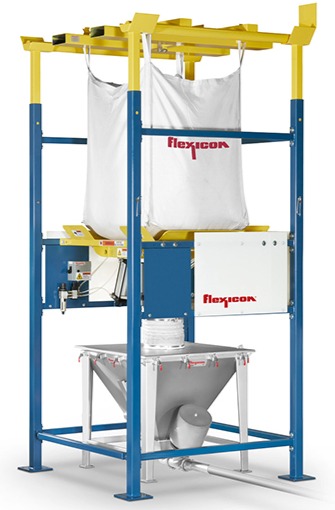Is Your Facility Safe In Processing Dry Products?
Pay attention to facility layout, airflows and cleaning to protect your employees, facility and product.

Be sure your dry processing facility is up to date, meeting NFPA rules and has the latest and safe dry processing equipment that prevents fugitive dust emissions that could result in a fire. Image courtesy of José Alfredo Velázquez from Pixabay
According to “Dust Safety Science,” the food products industry accounted for 48.4% of all fire and explosion incidents in 2022. In general, dust collectors were identified as the primary source of combustible dust problems, accounting for 24% of the incidents. Storage silos (21.1%) and dryers (20.7%) were also significant contributors.
Whether a processor is in a new facility designed to handle dry ingredients and products or an older structure that was once right-sized and fitted to handle the job in the past, new market demands often create the need to throw in more equipment and processes faster than they can be acclimated in the building. When this involves powders from grinding, sifting or mixing operations—or just plain material movement—facilities may no longer be able to handle the process safely and efficiently. Flammable dust that once was easily removed from the environment hangs around and accumulates where it shouldn’t. And due to inadequate training, the clean-up crew sometimes misses areas where dust accumulates.
“We have seen a number of facilities grow over the years by buying additional pieces of equipment and self-integrating them without working with a qualified integrator,” says Joshua Allen, process engineering manager for AD Process Equipment, a Gray Company. “When this occurs, a complete risk assessment is often not performed to fully understand the impact on the existing systems and the additional hazards that can be introduced to the facility. Improper repairs and maintenance on older equipment and repurposing of equipment for processes it was not intended have also been identified as leading to potentially dangerous situations.”

The Problems with Older Facilities
Typically, older facilities may have issues such as outdated ventilation systems, insufficient dust control measures and inadequate pressurization in critical areas, says Dennis Collins, CRB’s architectural discipline leader based in St. Louis, who is also a senior associate at CRB. “One common problem we observe is with the pressurization in rooms where raw materials are handled. Often, these rooms have negative air pressure, which allows outside air to infiltrate the processing areas. This can introduce contaminants and compromise the safety and quality of the materials being processed.”
Improving these facilities often requires a comprehensive assessment of the entire facility to identify all areas needing upgrades, adds Collins. “Addressing pressurization issues, for instance, involves not only correcting the airflow but also ensuring that the entire ventilation system is up to modern standards. This may include installing advanced filtration systems, upgrading HVAC systems and implementing better dust control technologies.”
Older facilities often house older equipment, says Adam Dittbenner, instrumentation manager at Interstates, a CSIA (Control System Integrators Association) certified member. This equipment has typically been in continuous, or near continuous, operation for a considerable amount of time, as well as in harsh environments. This equipment needs to be checked occasionally if it is to be relied upon for detecting hazardous situations in the facility (“Haz Mon” systems). In regard to power distribution equipment, dust often accumulates in electrical panels and gear over the course of time, as well. This dust needs to be cleaned out, and electrical gear needs to be checked to ensure it still operates properly. These checks include inspecting for good internal contacts and adequate insulation of energized parts, plus testing the ability to trip at the proper time to provide protection of downstream equipment.
“Sometimes older systems are not ideally sized or have been purchased from a legacy customer and are not being used for what they were originally intended,” says Brian Shoop, director of process and packaging, Gray Solutions, a CSIA certified member.
“The primary issue with older facilities is that they were not designed with the latest NFPA codes in mind, which means they often lack adequate explosion venting and isolation systems,” says Zac Ulmer, senior process engineer at Gray Solutions. “Older facilities usually have dust collection points meant for comfort rather than safety. To improve them, we often need to retrofit existing systems with modern dust control technologies, ensuring proper venting and isolation to prevent dust explosion propagation. It is a case-by-case decision whether retrofitting or rebuilding is necessary, but safety is always the priority. We work with our customers to lay out all the options for their consideration and work with them to make the best decision.”
New Equipment to the Rescue?
It may seem that dropping in new and safer dry processing equipment could be a way to rescue an existing dry powder facility that might not have all the accoutrements needed for safe operations. But, wouldn’t it be safer to rip and replace or build a new facility designed to safely handle dry processing applications from the get-go?
“Hazard monitoring systems and power distribution systems can be replaced, however they are often very integral to a facility,” says Interstates’ Dittbenner. Replacement of them requires electrical installation effort in addition to the new equipment. Performing maintenance on existing systems and ensuring they operate properly is typically a lower spend compared to replacement, and also allows for getting the full life out of the equipment.

Obviously, a new facility designed from the ground up specifically for the task is the safest thing to do, says AD Process Equipment’s Allen. “However, that is very expensive and time-consuming. There are often solutions that can be integrated into or added to existing facilities to help mitigate risks. Each situation is unique, and the important thing is to work with a qualified team that can identify and assess the risks and provide solutions.”
“While dropping in new equipment can improve safety, it is often highly site-specific and may not address all underlying issues of an existing facility,” says Gray’s Shoop. “Retrofitting can sometimes be more costly and complicated than building a new facility. Using tools like 3D scanning and virtual design coordination helps us assess the feasibility of retrofits before any physical changes are made. Ultimately, building a new facility allows for better placement of vents and equipment to meet NFPA codes and ensure optimal safety and efficiency, but that isn’t always the best answer.”
“It’s really that upfront analysis that will help you manage your risk—and does it make sense because, you know, even building a brand-new facility comes with its own risks,” says Ulmer.
Improvements in Dry Processing Equipment
There have been many improvements in the availability of equipment and controls designed and rated for use in hazardous locations, says Allen. “In the past, many systems relied on pneumatic spring scales in the hazardous environment. Now, we can install full instrumentation and load cells in hazardous environments, similar to how they would be utilized in non-hazardous situations. The key is working with the right team that can determine the risk, choose the appropriate level of controls required and provide them in a manner that they operate as intended. It should also be noted that educating employees about the risks and requirements plays an important role in ensuring that the equipment continues to operate safely once it is installed. Rated instrumentation, for example, must be reassembled according to design to maintain its integrity (you have to replace the O-ring if you lose it!).”
“Recent advancements in robotics and equipment for handling, processing and conveying dry products have brought significant improvements in both safety and efficiency, making them valuable investments for both older and new facilities,” says CRB’s Collins. Some notable advancements include:
- Explosion suppression systems: A large safety improvement, these systems detect and suppress potential explosions in their early stages, significantly reducing the risk of catastrophic events.
- Advanced robotics: Robots have become equipped to perform tasks such as grinding, mixing, and packaging with greater accuracy and speed, reducing human error and increasing overall efficiency.
- Precision mixing equipment: Advanced mixing equipment with improved control systems allows for precise blending of ingredients, ensuring uniformity and consistency in the final product.
One notable improvement is the use of enclosed bagging lines, which contain dust and improve safety by keeping operators away from dust exposure, says Gray’s Shoop. Additionally, slow-moving mechanical conveyors like “chainveyors” are replacing bucket elevators, reducing dust generation and improving safety. Robotics and automation have also advanced, particularly in packaging processes, where they enhance precision, reduce manual handling and minimize dust exposure. Technologies like hyperspectral imaging for raw material inspection can also improve safety and quality control.
Finally, before making any changes to your facility to accommodate new equipment, it’s a good idea to review the guidelines and requirements of NFPA to ensure mitigation of hazards caused by dust, says Dittbenner. “Interstates can help with reviewing these requirements and applying them to your facility. Sometimes new systems and equipment are needed, and sometimes existing equipment can be made sufficient by checking it and resolving any issues it is currently encountering.”

Evaluate Facilities before Upgrading Equipment
Processors should engage the services of an experienced firm to evaluate their facilities, says AD Process Equipment’s Allen. Any additions or changes should be performed by firms that have experience and knowledge about working with potentially hazardous situations. Even something as basic as buying a new piece of equipment that a maintenance team can easily install should be evaluated if it will be near or potentially create a hazardous environment.
Evaluating existing facilities and current operational procedures and equipment is crucial when planning improvements for food safety and employee safety, says CRB’s Collins. Processors should conduct a comprehensive review of the facility to identify areas needing upgrades, analyze current processes for efficiency and ensure compliance with food safety regulations. This involves assessing structural integrity, identifying outdated machinery and pinpointing bottlenecks where new technology could enhance productivity and safety.
Deciding whether to renovate, add on or replace a facility depends on the extent and cost of necessary upgrades, the future growth and flexibility of the facility and a detailed cost-benefit analysis comparing the options, adds Collins.
Evaluating existing facilities requires a thorough front-end analysis to manage risks and determine the best course of action, says Gray’s Ulmer. Factors to consider include the current condition of equipment, compliance with NFPA codes and potential safety hazards. Retrofit options should be weighed against the costs and benefits of building new facilities. Often, older facilities may be operating unsafely, and significant upgrades are necessary to meet modern standards. A detailed assessment and cost analysis can help processors decide whether to renovate, add on or replace their facilities.
Stay Safe
An important aspect of dry processing safety is ensuring proper housekeeping and maintenance to prevent dust accumulation, says Gray’s Shoop. “Implementing explosion-proof central vacuum systems can help maintain cleanliness and safety. Additionally, staying updated with industry standards and regulations, such as those from NFPA and insurance carriers, is crucial for maintaining safe operations. Our ability to use advanced tools like 3D scanning and virtual design coordination allows us to address safety concerns effectively and design efficient systems tailored to each facility’s specific needs.”
Looking for a reprint of this article?
From high-res PDFs to custom plaques, order your copy today!






